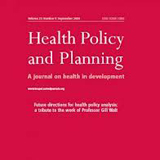
The World Health Organization recommends birth and emergency preparedness (BEP) as essential components of the Focused Antenatal Care model. The purpose of providing BEP messages to women during their antenatal visits is to increase the use of skilled attendance at childbirth. However, the effectiveness of this component has not yet been clearly established in routine contexts. This retrospective cohort study examined the association between exposing women to BEP messages during antenatal visits and the use of the skilled attendance at childbirth in two rural districts of Burkina Faso (Koupela and Dori). The study included 456 antenatal care users in 30 rural health centres in these two districts. Data were collected using modified questionnaires from the Johns Hopkins Program for International Education in Gynecology and Obstetrics and from demographic and health surveys. Logistic regression was performed with a model of generalized estimating equation to adjust for clustered effects. In the Koupela district, where the rate of institutional deliveries (80%) was relatively high, the use of BEP messages was not associated with an increase in institutional deliveries. In contrast, in the district of Dori, where the rate of institutional deliveries (47%) was lower, messages regarding danger signs [Adjusted Odds Ratio (AOR) = 1.93; 95% Confidence Interval (CI): 1.07, 3.49] and cost of care (AOR = 2.13; 95% CI: 1.09, 4.22) were associated with an increased probability of institutional births. Based on these results, it appears that birth and emergency preparedness messages provided during antenatal visits may increase the use of skilled attendance (increase the rate of institutional births) in areas where institutional births are low. Therefore, it is important to adapt the content of the messages to meet the particular needs of the users in each locality. Furthermore, BEP counselling should be implemented in health facilities.